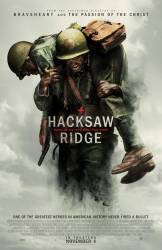Factual error: Throughout the battle scenes on the ridge, the machine gunners can be seen picking up the guns to fire on the move. While not impossible, not as painless as it is made to appear. The M1919 .30 caliber air cooled machine gun was light enough to carry. But for the gunner to hold an already hot barrel and continue firing would have been extremely painful without the issued heat retardant mitten or the barrel "hoop" w/ wooden handle. These fixes allowed the gun to be fired on the move and saved many from having their palms burned and scarred for life.
Suggested correction: They have barrel shrouds which dissipate the heat and allow a grip...they are not in contact with the barrel.
Revealing mistake: When the stretcher is being lowered down on the line, the high tension steel wires can be seen under the hessian rope.
Suggested correction: I don't see this as an error, because just before they lower him down, it is obvious that they have rigged a tripod and cable at a much lesser angle than straight down the face of the cliff. Once the cleanup phase started, additions like this would have been normal to remove the dead and wounded.
I am 100% certain this is an error.
The stretcher is seen lowered down hung from ropes tied at each corner, which would have really happened. Obviously this wouldn't meet safety requirements for filming, so they've "hidden" steel cables in the rope. The error is that the cables and the screw-in anchors in the stretcher are visible. Also the rope on some of the corners is visibly slack as a result.
This doesn't refer to the tripod and cable rig. Just as the stretcher starts moving, the camera shows it moving off to the left with the other soldiers watching on. One of the soldiers is holding one of the ropes that attach to the stretcher. When he lets go, it reveals that the rope is frayed, revealing the steel wire that is threaded through the rope. It's the wire that's attached to the stretcher, not the rope.
Factual error: When Sergeant Howell is first introduced, the corporal assisting him calls the barracks to attention. You do not call "attention" for an NCO, however - you call "at ease."
Suggested correction: They are in boot camp. You stand at attention when they say you stand at attention. Especially when your Drill Sergeant walks in.
This is absolutely incorrect. In the United States Army, soldiers stand "at ease" in the presence of a non-commissioned officer (such as a drill sergeant). Soldiers only stand at "attention" when in formation or in the presence of a commissioned officer. Having served, I am very well acquainted with the appropriate procedure.
Suggested correction: When you are in basic training, if you are called to attention you come to attention...if you are told to bend over and scratch your 6, you do just that...these men are not yet soldiers.
Factual error: When the Japanese commander is committing seppuku near the end of the final battle, after he makes the first cut his second cuts his head clean off, and it can be seen falling to the ground in front of his body. While having a second perform this act was indeed commonly part of the ritual, the second was actually supposed to ensure that the neck was not cut cleanly through, i.e. He was supposed to stop short and leave the head attached to the body by a small flap of tissue. It was considered extremely undignified and unnecessarily messy for the head to come clean off and roll around on the ground. For that reason, it was important to choose a second who was a skilled swordsman.
Suggested correction: While factually you are correct, s**t happens...when does anything in war go as it's supposed to? Just because something is supposed to go a certain way and doesn't, doesn't mean it was a mistake in the filming.
Stupidity: When Doss buried the wounded soldier, leaving one eye out made no sense. It did nothing to help him. All it did was make it easier for the Japanese to spot him. It would've made sense to leave his nose and/or mouth out, so he could breathe. He did not need to see.
Suggested correction: A person who is unable to see is more likely to panic. When Doss buried the wounded Marine, he asked him to take a deep breath and trust him. By leaving one eye open, it allowed him to see the gravity of the situation as IJA soldiers walked by and maintain eye contact with Doss who hid under a dead Marine. After the suspicious IJA soldier bayoneted the body over Doss, he looked directly at where the wounded man was buried and kept walking. It was a crude method, but it likely saved them both.





